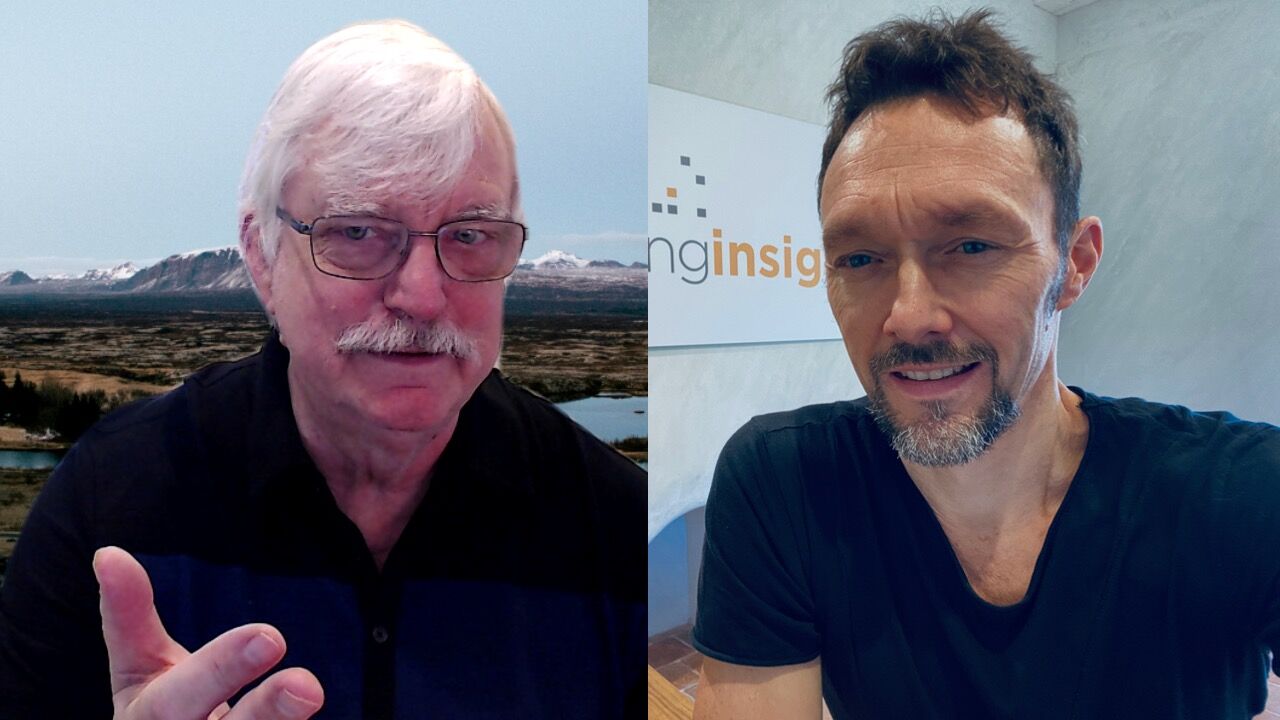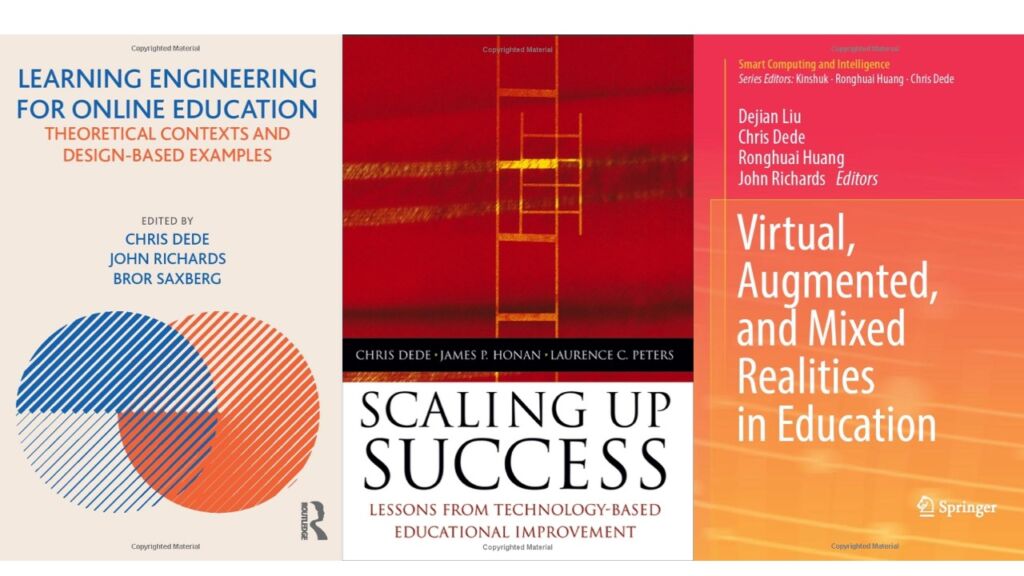Insights interview: how to engineer edtech for learning and adoption at scale

What’s the purpose of this interview and who’s it for?
History shows that edtech that is sticky and adopted at scale has two common characteristics. First, it’s adaptable and easy to use (relative to the perceived benefits). And second, it’s impactful (it solves important problems with measurable results). But, neither can be retrofitted—they need to be the foundations of your solution design. What’s more, the stakes are simply too high for learners and for edtech companies making sizable investments. Fortunately, user-centered design is the key to achieving usability. And, educational research provides the principles for you to engineer your edtech for learning and adoption at scale. For this interview, I wanted to explore the latter and tap into the insights of a world-renowned expert.
Why Professor Chris Dede?
Professor Chris Dede of the Graduate School of Education at Harvard University is one of my career-long heroes. His research interests and impact on edtech and education reform are wide and deep. But, there are three areas that Chris has focused on that I think are particularly valuable to leaders in edtech looking to the future:
- “Learning engineering.” Chris is an expert in optimising edtech and educational ecosystems using research-driven design, analytics, and iterative experimentation.
- “Edtech for scale.” Chris has dedicated his career to driving sustainable educational reforms and understanding the characteristics of edtech that enable such changes.
- “Education of the future.” Chris is a pioneer of educational innovation and runs research to develop and assess learning environments using virtual worlds, augmented realities, social interactions, and online teacher development.
Here are just a few of his books:

With such rich pickings, where to start?
The interview
Good morning, Chris. I’m thrilled to be interviewing you. As you know, I work with edtech startups to help them scale and large educational businesses with their digital acceleration. With that audience in mind, I wanted to laser in on three areas of your expertise and ask you to pull out some practical lessons on learning engineering, edtech that sticks and scales, and education of the future. Are you up for that?
I really appreciate your asking me to share ideas on these important topics.
Learning Engineering
How would you explain Learning Engineering and its value to an edtech team?
Big data is already utilized for decision making in higher education; one example is early identification of at-risk students based on analysis of their behavioral patterns. To date, these analyses focus on students’ macro-behaviors (e.g., adding or dropping courses) rather than their micro-behaviors (second-by-second activities in online learning experiences coupled with evidence about learning outcomes). Both online teaching and blended instruction (online plus face-to-face) are good venues for “engineering” learning because the digital media used automatically generate rich, time-stamped logfiles of each student’s interactions with curricular materials, peers, and instructors. As an example, online students can experimentally receive either explanatory videos of how to solve a type of problem or worked examples to illustrate the problem solving strategy; analytics can establish which type of explanation is better for different kinds of students. In this way, “Learning Engineering” applies a principled set of evidence-based strategies to the continual re-design of educational experiences to optimize their effectiveness and efficiency.
What are areas where you believe current edtech fails to exploit Learning Engineering to best serve learners and instructors?
In higher education, the pandemic has forced faculty to teach remotely for the past few months and is likely to force distance or blended learning for future academic terms. Discussion about this disruption has disproportionally emphasized the disadvantages of online instruction as opposed to face-to-face teaching. A more objective analysis would highlight the advantages of online learning too, such as the ability to continually redesign instruction to optimize and personalize its impact. Learning Engineering also provides incentives for faculty to develop alternative ways of teaching, rather than one-size-fits-all instruction. In addition, Learning Engineering can provide feedback to students about how they can best invest their time to efficiently gain optimal outcomes.
If you had to pick three areas that edtech could make the greatest advances from Learning Engineering, what would they be and why?
Imagine a hospital doctor who has only summative feedback on whether her treatments are helping patients: whether a person dies or is released as now healthy. Without multi-dimensional, frequent, longitudinal, diagnostic data that enable formative shifts in her therapies, this doctor is severely handicapped in curing her patients. K12 educators face this unfortunate situation constantly because their primary source for feedback and accountability is infrequent, drive-by, high-stakes tests. Now that precollege teaching has been forced into remote learning by the pandemic, Learning Engineering could develop embedded diagnostics that provide formative feedback for students and teachers, as well as generating trajectories of performance gains over time to inform parents, school administrators, policy makers, and other stakeholders.
There’s a gulf between primary educational research literature and practical guidelines edtech developers can use. What resources would you point them to?
My 2018 book co-edited with Richards and Saxberg, Learning engineering for online education: Theoretical contexts and design-based examples, provides practical advice and illustrations for higher education. Another good resource is Clark and Mayer’s 2016 book, e-Learning and the science of instruction: Proven guidelines for consumers and designers of multimedia learning. A third resource is Willcox, Sarma, and Lippel’s 2016 report, Online education: A catalyst for higher education reforms.
Edtech that scales
Let’s move on to the second big topic, edtech that’s sticky and drives sustainable educational improvements. A common problem I come across is edtech developers underestimating the challenges teachers face adopting new technology and the support they need. What advice would you give?
Unlearning is the biggest barrier teachers face in using technologies that make transformational changes in their current instructional methods. In adopting these technologies, teachers have to let go of deeply-held, emotionally-valued identities in order to shift to a different, more effective set of behaviours. For example, teachers may need to transform their instructional practices from presentation and assimilation to active, collaborative learning by students. This type of unlearning requires not only novel cognitive insights and approaches, but also emotional and social support for shifting professional roles from lecturers to coaches. Achieving adoption of any transformative edtech requires powerful methods for unlearning and capacity building in the teachers who will implement this new model.
Given these challenges, are there lessons you would share for how to design edtech that is more “self supporting”—that facilitates teacher onboarding and has built-in professional development?
Yes, there are three important factors to designing scalable innovations in learning:
1. Move beyond a one-size-fits-all: Every educational setting is unique in its characteristics, and scalable edtech needs to be designed so teachers can modify its operation to fit their students, educational objectives, instructional strengths, and classroom context.
2. Start novices with an easy-to-use version: designing your edtech to reduce the resources and expertise required to start using it shows its potential power and encourage users to expand their capabilities to exploit the innovation’s full power.
3. Shift ownership: moving beyond the “push model” of edtech development to include educators as co-evaluators, co-designers, and co-scalers—so that they have agency and voice to adapt, not simply adopt.
To accomplish these strategies, scalability must be taken into account from the earliest stages of design; retrofitting later is just not viable.
What other characteristics have you identified of edtech that is sticky and is adopted at scale that edtech developers can learn from?
It’s important to show through evaluation that the edtech is worth keeping because of its efficiency and impact. Doing ongoing research to understand and enhance the causes of its effectiveness increases its sustainability. Moreover, learning from users’ adaptations to their own situations provides valuable insights about how to evolve and customize the innovation’s model.
Edtech of the future
Agreed! Finally, let’s move on to the third topic: education of the future. How do you think education, teaching, and learning will change in the next 5 years and why?
For more than four decades, I have been working to help educators move beyond one-size-fits-all teaching-by-telling and learning-by-listening. One insight I’ve gained is that people believe they need additional resources to transform standard practices. But when people are given extra assets, they use these to do more of the same: in other words, old wine in new bottles. Now, civilization is in crisis, and educators cannot make every home into a remote classroom. I worry that we will keep trying to impose an obsolete model on a new situation and, as the pandemic gradually recedes, that we will revert to traditional practices without modifying them to take advantage of innovations now emerging.
Can you contrast this with do you think education teaching and learning should change in the next 5 years and why?
I hope we will use this opportunity to create a more effective, universal model of instruction based on modern knowledge about learning, a system that provides every student the support to reach their full potential through a “new normal” of universal, blended, personalized, lifelong learning. One type of emerging edtech that can aid with this is immersive authentic simulations; an example is EcoXPT, a middle school curriculum my colleagues and I are releasing for free use by teachers and parents. Another type of immersive medium for learning is digital puppeteering; I am studying this for learning the complex psychosocial skill of negotiation. Also, compared to two decades ago, we have a near-universal, powerful communications infrastructure for developing new models of education: the internet, mobile devices, and social media. Social media enable building online communities for creativity, collaboration, and sharing; I believe the design of new models for formal education should be based on the devices and media people already are using for informal learning.
As we wrap up, are there any other takeaways you’d like to give to edtech developers?
This is an exciting time that offers unique opportunities as well as challenges. As people miss familiar supports and traditions, they are “cursing the darkness”—but edtech can light candles that illuminate new horizons for learning.

Thank you so much! This has been fascinating.
Adam, your work is an inspiration for me, so I am happy to be part of what you are accomplishing.
Takeaways
Chris provides several battle-worn lessons that resonate with my own experiences of how to engineer edtech for learning and adoption at scale. In summary:
- Use Learning Engineering to design, systematically measure, and iteratively improve your product—if you want your edtech to be impactful and to deliver educational value.
- Involve learners and teachers at every step—if you want your edtech to be empathetic, easily adapted and adopted, and ultimately sticky and scalable.
- Obsess about the barriers your users may face adopting a new product—understand their differing contexts, established practices, and personal perspectives, design to make “first use” dead easy and to quickly reveal benefits, provide authentic teacher training and support, and grow a community of teachers to help each other.
If you want a fast and incisive assessment of your current approach and practical tips for how to accelerate, please contact us today with the form provided below.
